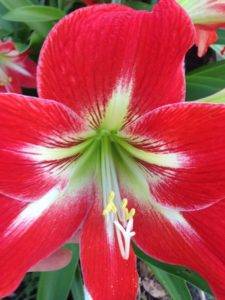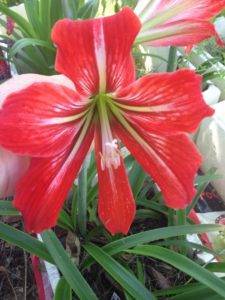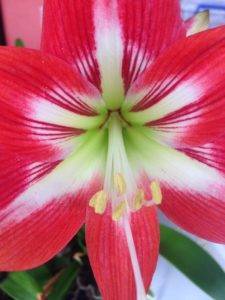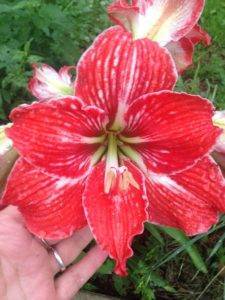All the bulbs I have grown from seed are now starting to flower, and letting me know what they are. I obviously have some that are multiples of what I need. And Listed below are the red white bulbs I have for sale.
Bulbs on this page are all $10.00 each for flowering size and $5.00 for pups. (if I have any)
Between the items is an article on some technical info on bulbs.
This article is about bulbs as defined botanically. For bulbs in the wider gardening sense, see Ornamental bulbous plant.
Red & White stripe, picotee, green throat, compact.
North fence
Hippeastrum (amaryllis) bulb
In botany, a bulb is a short stem with fleshy leaves or leaf bases that function as food storage organs during dormancy.
Red White Stripe yellow centre, scented. Pot
(In gardening, plants with other kinds of storage organ are also called “ornamental bulbous plants” or just “bulbs”.)
Home Red – bold white, yellow centre. Sth fence. Feathery
A bulb’s leaf bases, also known as scales, generally do not support leaves, but contain food reserves to enable the plant to survive adverse weather conditions. At the center of the bulb is a vegetative growing point or an unexpanded flowering shoot.
Red- Orange, White star yellow centre.
Cocktail star
The base is formed by a stem, and plant growth occurs from this basal plate. Roots emerge from the underside of the base, and new stems and leaves from the upper side.

Red White No 10 Striking
Tunicate bulbs have dry, membranous outer scales that protect the continuous lamina of fleshy scales. Species in the genera Allium, Hippeastrum, Narcissus, and Tulipa all have tunicate bulbs. Non-tunicate bulbs, such as Lilium and Fritillaria species, lack the protective tunic and have looser scales.

Spidery Red White stripe
Longitudinal section through bulb, Cross section of onion bulb
Other types of storage organs (such as corms, rhizomes, and tubers) are sometimes referred to as bulbs, although as the term is used in botany, they are not.
Red Orange, White & yellow throat – Cocktail
The technical term for plants that form underground storage organs, including bulbs as well as tubers and corms, is geophyte. Some epiphytic orchids (family Orchidaceae) form above-ground storage organs called pseudobulbs, that superficially resemble bulbs.

Red White, mauve blush, Green throat. Box No 73
Nearly all plants that form true bulbs are monocotyledons, and include:
Amaryllis, Crinum, Hippeastrum, Narcissus, and several other members of the amaryllis family Amaryllidaceae. This includes onion, garlic, and other alliums, members of the Amaryllid subfamily Allioideae.
Lily, tulip, and many other members of the lily family Liliaceae.
Two groups of Iris species, family Iridaceae: subgenus Xiphium (the “Dutch” irises) and subgenus Hermodactyloides (the miniature “rock garden” irises).
Oxalis, in the family Oxalidaceae, is the only dicotyledon genus that produces true bulbs.[4][5]
Bulbous plant species cycle through vegetative and reproductive growth stages; the bulb grows to flowering size during the vegetative stage and the plant flowers during the reproductive stage. Certain environmental conditions are needed to trigger the transition from one stage to the next, such as the shift from a cold winter to spring.[2] Once the flowering period is over, the plant enters a foliage period of about six weeks during which time the plant absorbs nutrients from the soil and energy from the sun for setting flowers for the next year. Bulbs dug up before the foliage period is completed will not bloom the following year but then should flower normally in subsequent years.
After the foliage period is completed, bulbs may be dug up for replanting elsewhere. Any surface moisture should be dried, then the bulbs may be stored up to about 4 months for a fall planting. Storing them much longer than that may cause the bulbs to dry out inside and become nonviable.






